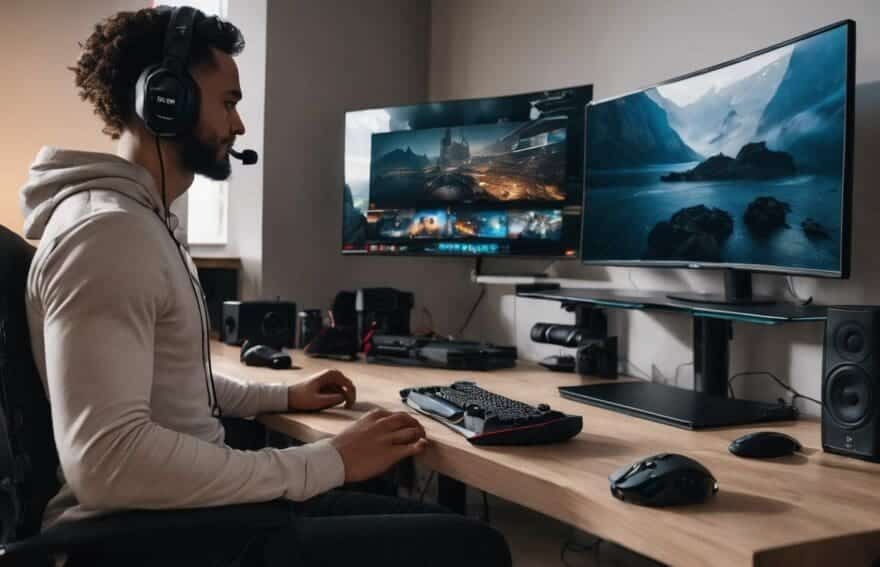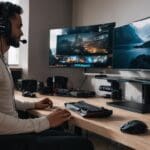Esports Injuries and How to Avoid Them: A Health Guide

Updated On: October 29, 2025 by Aaron Connolly
If you’re quite the enthusiast when it comes to gaming, it’s more than likely you’ve experienced the toll an intense gaming spree can take on your wellbeing. We understand because we’ve been in that very situation – and it’s no trifling matter.
In fact, research tells us that over a third of mobile esports athletes report discomforts like nagging headaches. That’s precisely why we’ve put our heads together to create an insightful guide designed to help you dodge those irksome injuries.
Get ready to arm yourself with practical advice for maintaining peak performance whilst keeping the aches and pains at bay – allow us to illuminate the way for you!
The Physical Demands of Esports
Esports involves long hours of gaming, which can lead to overuse injuries and strain on the body. Posture and equipment play a crucial role in preventing physical health issues, while maintaining physical fitness is essential for peak performance.
Overuse injuries
As we dive into the realm of gaming, overuse injuries like carpal tunnel syndrome become significant concerns for many of us. Prolonged sessions gripping controllers or clicking mice can lead to repetitive strain on our wrists and fingers.
It’s not just about discomfort; these conditions can seriously hinder our gameplay and even force us off our beloved platforms if ignored.
We know that keeping an eye out for early signs of strain is key to avoiding long-term damage. Introducing regular stretch breaks every hour helps keep those joints moving, which is crucial in preventing the stiffness and pain associated with overuse injuries.
Ignoring twinges or persistent aches isn’t worth the risk – after all, sustaining our health ensures we can keep enjoying gaming without unplanned interruptions.
Posture and equipment
Maintain good posture during gaming by sitting up straight, with your feet flat on the floor and your elbows at a 90-degree angle. Use an ergonomic chair and position the monitor at eye level to reduce strain on your neck and back.
Adjust the keyboard and mouse so that your wrists remain straight, preventing repetitive strain injuries like carpal tunnel syndrome. Ensure proper lighting to reduce eye fatigue and use blue light filters on screens to minimise vision issues from prolonged gaming sessions.
Invest in equipment designed for comfort and support during long gaming sessions. Consider using wrist rests, footrests, or lumbar support cushions to maintain a healthy posture while playing.
Additionally, opt for ergonomic peripherals such as keyboards and mice that promote natural hand positioning. Lastly, take regular breaks to stretch and walk around to combat the negative effects of prolonged sitting.
Physical fitness
Esports athletes must prioritise physical fitness to prevent gaming-related injuries. Regular exercise is crucial in maintaining overall well-being and preventing musculoskeletal problems.
Integrating cross-training activities like yoga, stretching, or strength training can help improve flexibility, posture, and muscle strength. Additionally, incorporating regular breaks during gameplay sessions can minimise the risk of overuse injuries and promote better physical health for esports athletes.
To maintain a healthy lifestyle as an esports athlete, it’s essential to stay active outside of gaming hours. Engaging in cardio exercises such as cycling or running boosts cardiovascular endurance and promotes general fitness.
Common Esports Injuries
Musculoskeletal injuries, such as carpal tunnel syndrome and tendonitis, are common among gamers due to prolonged periods of repetitive hand movements. Ophthalmological issues like digital eye strain and dry eyes can also occur from staring at screens for extended periods.
Additionally, nutrition-related problems and mental health concerns, such as stress and burnout, are prevalent in the esports community.
Musculoskeletal injuries
Esports athletes are at risk of musculoskeletal injuries due to prolonged gaming sessions and repetitive movements. To prevent these injuries, consider the following tips:
- Practise good posture while gaming to reduce strain on your muscles and joints.
- Take regular breaks to stretch and move around, preventing stiffness and promoting blood flow.
- Use ergonomic equipment and furniture that supports a healthy gaming position, reducing the risk of strains and sprains.
- Incorporate strength training exercises into your routine to improve muscular endurance and support better posture during long gaming sessions.
- Pay attention to any signs of discomfort or pain in your muscles or joints, seeking help from a healthcare professional if needed.
Ophthalmological issues
Our extensive gaming sessions can lead to eye strain and discomfort, but a few simple adjustments can help alleviate these problems. Here are some tips to prevent ophthalmological issues while gaming:
- Position your monitor at arm’s length and slightly below eye level to reduce eyestrain.
- Follow the 20-20-20 rule: every 20 minutes, look at something 20 feet away for 20 seconds to give your eyes a break.
- Adjust the brightness and contrast of your screen to reduce glare and make it easier on your eyes.
- Use artificial tears to lubricate your eyes if they feel dry or uncomfortable during long gaming sessions.
- Ensure adequate ambient lighting in the room to reduce the strain on your eyes from staring at a bright screen in a dark environment.
Nutrition-related problems
Transitioning from ophthalmological concerns to nutrition-related issues, it’s important for gamers to be aware of the impact of their diet on their gaming performance and overall health. Here are some key points to consider:
- Maintaining a balanced diet with adequate nutrients is crucial for sustaining energy levels and promoting overall well-being during prolonged gaming sessions.
- Consuming high-sugar and high-fat snacks can lead to fatigue and decreased mental acuity, impacting gaming performance.
- Dehydration can affect focus and reaction time, so it’s essential for esports athletes to stay hydrated by drinking plenty of water or electrolyte-enhanced beverages.
- Incorporating a variety of fruits, vegetables, lean proteins, and whole grains into your diet can provide essential vitamins and minerals that support physical and mental endurance during gaming sessions.
- Avoid excessive caffeine intake as it can disrupt sleep patterns and contribute to increased stress levels, affecting both performance and recovery.
- Planning balanced meals and snacks ahead of gaming sessions can help maintain sustained energy levels without relying on unhealthy options.
Neurological and mental health concerns
Esports can pose neurological and mental health concerns for gamers. Managing these issues is crucial to maintaining overall well-being.
- Extended gaming sessions can lead to sleep disturbances and fatigue, affecting cognitive function and mental well-being.
- Vision issues such as digital eye strain and headaches are common among esports athletes, warranting attention to prevent long-term impacts on vision and mental health.
- Prolonged exposure to screens without adequate breaks can contribute to stress, anxiety, and mood disorders, highlighting the importance of managing screen time for better mental health.
- Gamers are at risk of developing musculoskeletal problems due to prolonged sitting and repetitive movements, which can impact neurological well-being by causing discomfort or pain.
- The intense focus required during competitive gameplay can lead to heightened stress levels, impacting neurological health if not managed effectively through relaxation techniques.
- Overuse injuries like carpal tunnel syndrome may affect both physical and mental well – being due to limitations in mobility and potential impact on gaming abilities.
- Addressing mental health concerns is crucial for esports athletes through support systems, professional guidance, and regular self-assessment to ensure optimal performance and balanced well-being.
Tips for Preventing Esports Injuries
To avoid esports injuries, it’s important to take regular breaks, use ergonomic equipment, and be mindful of your senses while gaming. Incorporating cross-training and exercise into your routine can also help prevent overuse injuries and improve overall physical fitness for gaming.
Take breaks
To avoid overuse injuries and maintain optimal gaming performance, it’s essential for esports athletes to take regular breaks during their gaming sessions. Incorporating stretch breaks at least once every hour is crucial in preventing musculoskeletal problems and repetitive motion injuries.
These breaks allow the body to rest, reduce strain on muscles and joints, and help to prevent the potential health risks associated with prolonged gaming sessions. Additionally, incorporating specific gaming stretches into these break periods can help keep joints moving and maintain flexibility, further reducing the risk of injury.
Ensuring that physical health is prioritised alongside gameplay not only prevents injuries but also supports sustained performance in esports. By taking focused breaks throughout playtime, gamers can safeguard their well-being while optimising their abilities during competitive events or casual gaming sessions.
Use ergonomic equipment
To prevent gaming-related injuries, we need to prioritise using ergonomic equipment. This includes investing in an adjustable, supportive chair that promotes good posture and reduces the risk of musculoskeletal problems.
Additionally, choosing a keyboard and mouse designed for comfort and efficiency can help minimise strain on the hands and wrists during long gaming sessions.
Moreover, consider using wrist rests to provide adequate support and reduce the likelihood of developing carpal tunnel syndrome. Utilising monitor arms or stands to adjust screen height can also help in maintaining proper eye level alignment.
Be mindful of your senses
Stay attentive to your body’s signals and adjust your gaming environment to reduce strain on your eyes, hands, and wrist. Position yourself at an arm’s length from the screen with the top of the monitor at or just below eye level.
Ensure proper lighting in the room to minimise glare on the screen, and use wrist supports and ergonomic mice to prevent hand fatigue and strain. Take regular breaks every hour to rest your eyes, stretch your fingers, and relax tense muscles.
Stay hydrated with water and maintain a balanced diet rich in essential nutrients to support overall wellness during intense gaming sessions.
Incorporate good posture habits by sitting straight with feet flat on the floor and elbows close to your sides as you play. Practise deep breathing exercises during breaks to alleviate mental stress while also relaxing physical tension for improved focus and well-being.
Incorporate cross-training and exercise
To enhance our physical well-being and minimise the risk of esports injuries, integrating cross-training and exercise into our routine is essential. Engaging in activities such as yoga, Pilates, or strength training can help to improve muscular flexibility, posture, and overall physical endurance.
Regular exercise also contributes to better mental focus and cognitive performance during gaming sessions.
Furthermore, incorporating moderate aerobic exercises like brisk walking or cycling can boost cardiovascular health and enhance blood circulation throughout the body. These activities play a crucial role in preventing overuse injuries often associated with prolonged periods of sitting while gaming.
Seeking Professional Care for Esports Athletes
When it comes to addressing the physical and mental health needs of esports athletes, seeking professional care is crucial. Whether it’s through specialised programmes like the Cleveland Clinic Esports Medicine Programme or following Mayo Clinic’s E-sports Health and Safety Recommendations, getting expert guidance can make a world of difference in maintaining optimal health and wellness as a gamer.
To learn more about how you can take care of yourself while gaming, continue reading our comprehensive health guide for esports athletes.
Cleveland Clinic Esports Medicine Program
The Cleveland Clinic Esports Medicine Program is a pioneering initiative designed to address the unique healthcare needs of esports athletes. With a focus on injury prevention, improved performance, and overall well-being, this programme emphasises the importance of proactive care for gamers.
Through specialised health management models, the programme aims to identify potential health issues early and provide comprehensive care tailored to the specific challenges faced by esports athletes.
This includes addressing musculoskeletal problems, vision issues, sleep disturbances, overuse injuries like carpal tunnel syndrome and incorporating cross-training exercises to enhance physical fitness.
As part of their approach, the Cleveland Clinic Esports Medicine Programme provides pre-participation screenings and regular health check-ups for esports athletes. These efforts are essential in identifying any underlying health concerns or injuries that could affect gaming performance.
Mayo Clinic’s E-sports Health and Safety Recommendations
Transitioning from discussing the Cleveland Clinic Esports Medicine Program, we turn our attention to Mayo Clinic’s E-sports Health and Safety Recommendations. As passionate gamers, it’s crucial to prioritise our well-being while indulging in our favourite pastime.
Mayo Clinic emphasises the significance of integrating health management models to ensure that esports athletes maintain their overall well-being. With a focus on managing care and addressing potential health issues or injuries, these recommendations are tailored to safeguard the health of esports athletes.
Mayo Clinic highlights the importance of regular pre-participation screening and health check-ups for esports athletes. This proactive approach aims to identify any underlying health concerns early on, thereby minimising their impact on an athlete’s performance.
Addressing Physical and Mental Health Needs
Esports athletes must prioritise their physical and mental health to perform at their best. Regular exercise, proper nutrition, and adequate rest are essential for maintaining overall well-being.
It’s important to incorporate stretching exercises and ergonomic equipment to prevent musculoskeletal problems like carpal tunnel syndrome or back pain. Additionally, seeking professional care from healthcare providers familiar with esports injuries can help address any issues promptly.
Mental health is equally vital for esports athletes. Managing stress levels, taking breaks, and practising mindfulness techniques can contribute to a healthier mindset. Effective communication within teams and the development of coping strategies are crucial in alleviating pressure and fostering a positive gaming environment.
Prioritising both physical and mental well-being will enhance gamers’ performance on the virtual battlefield while safeguarding their long-term health.
Conclusion
In conclusion, preventing gaming injuries is crucial for the health and well-being of esports athletes. Taking regular breaks, using ergonomic equipment, and incorporating exercise are effective strategies for injury prevention.
Seeking professional care and adhering to health guidelines can help manage and prevent potential esports-related injuries. Maintaining overall wellness is essential for gamers to continue enjoying their passion for esports with minimised health risks.
FAQs
1. What are common esports injuries and how can they be avoided?
Common esports injuries include overuse and repetitive motion injuries from gaming, which can be prevented through proper gaming posture, regular breaks, and health and wellness guidelines tailored for esports athletes.
2. Why is an esports athlete’s health important?
An esports athlete’s health is vital because it affects their skills and effectiveness in the game. Preventing gaming-related injuries ensures they maintain peak performance during competitions.
3. How does gaming posture contribute to preventing injuries?
Adopting a correct gaming posture helps prevent overuse and repetitive motion injuries by aligning the body properly, reducing strain on muscles during long gaming sessions.
4. Can ergonomic equipment help in avoiding Esports Injuries?
Yes, using ergonomically designed equipment positions your body comfortably, reducing the risk of developing gaming injuries associated with poor posture during play.
5. Are there specific strategies for injury prevention in electronic sports?
There are many strategies for injury prevention in electronic sports that range from improving fitness levels to adopting safer practices such as frequent rests and proper positioning of equipment for optimum gamer’s healthcare.
6. What are some tips for maintaining esport player health outside of games?
Outside of actual gameplay time, focusing on overall wellness through fitness routines suited to gamers’ needs alongside general healthcare advice contributes greatly to preventing potential Esports Injuries.


